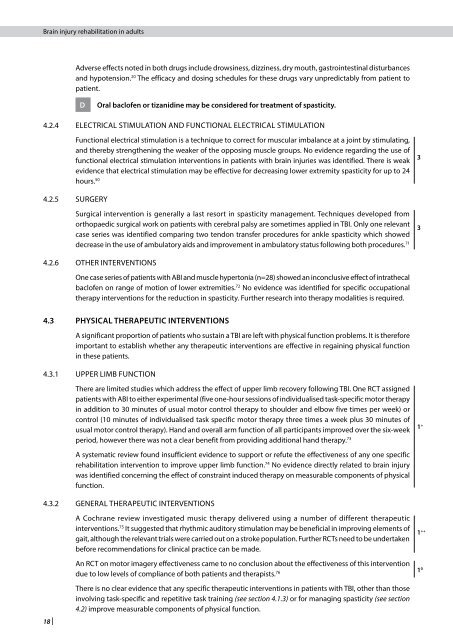sign130
sign130
sign130
Create successful ePaper yourself
Turn your PDF publications into a flip-book with our unique Google optimized e-Paper software.
Brain injury rehabilitation in adults<br />
18 |<br />
Adverse effects noted in both drugs include drowsiness, dizziness, dry mouth, gastrointestinal disturbances<br />
and hypotension. 20 The efficacy and dosing schedules for these drugs vary unpredictably from patient to<br />
patient.<br />
D oral baclofen or tizanidine may be considered for treatment of spasticity.<br />
4.2.4 ELECTRICAL STIMULATION AND FUNCTIONAL ELECTRICAL STIMULATION<br />
Functional electrical stimulation is a technique to correct for muscular imbalance at a joint by stimulating,<br />
and thereby strengthening the weaker of the opposing muscle groups. No evidence regarding the use of<br />
functional electrical stimulation interventions in patients with brain injuries was identified. There is weak<br />
evidence that electrical stimulation may be effective for decreasing lower extremity spasticity for up to 24<br />
hours. 50<br />
4.2.5 SURGERy<br />
Surgical intervention is generally a last resort in spasticity management. Techniques developed from<br />
orthopaedic surgical work on patients with cerebral palsy are sometimes applied in TBI. Only one relevant<br />
case series was identified comparing two tendon transfer procedures for ankle spasticity which showed<br />
decrease in the use of ambulatory aids and improvement in ambulatory status following both procedures. 71<br />
4.2.6 OTHER INTERVENTIONS<br />
One case series of patients with ABI and muscle hypertonia (n=28) showed an inconclusive effect of intrathecal<br />
baclofen on range of motion of lower extremities. 72 No evidence was identified for specific occupational<br />
therapy interventions for the reduction in spasticity. Further research into therapy modalities is required.<br />
4.3 PHySICAl THERAPEuTIC INTERVENTIoNS<br />
A significant proportion of patients who sustain a TBI are left with physical function problems. It is therefore<br />
important to establish whether any therapeutic interventions are effective in regaining physical function<br />
in these patients.<br />
4.3.1 UPPER LIMB FUNCTION<br />
There are limited studies which address the effect of upper limb recovery following TBI. One RCT assigned<br />
patients with ABI to either experimental (five one-hour sessions of individualised task-specific motor therapy<br />
in addition to 30 minutes of usual motor control therapy to shoulder and elbow five times per week) or<br />
control (10 minutes of individualised task specific motor therapy three times a week plus 30 minutes of<br />
usual motor control therapy). Hand and overall arm function of all participants improved over the six-week<br />
period, however there was not a clear benefit from providing additional hand therapy. 73<br />
A systematic review found insufficient evidence to support or refute the effectiveness of any one specific<br />
rehabilitation intervention to improve upper limb function. 74 No evidence directly related to brain injury<br />
was identified concerning the effect of constraint induced therapy on measurable components of physical<br />
function.<br />
4.3.2 GENERAL THERAPEUTIC INTERVENTIONS<br />
A Cochrane review investigated music therapy delivered using a number of different therapeutic<br />
interventions. 75 It suggested that rhythmic auditory stimulation may be beneficial in improving elements of<br />
gait, although the relevant trials were carried out on a stroke population. Further RCTs need to be undertaken<br />
before recommendations for clinical practice can be made.<br />
An RCT on motor imagery effectiveness came to no conclusion about the effectiveness of this intervention<br />
due to low levels of compliance of both patients and therapists. 76<br />
There is no clear evidence that any specific therapeutic interventions in patients with TBI, other than those<br />
involving task-specific and repetitive task training (see section 4.1.3) or for managing spasticity (see section<br />
4.2) improve measurable components of physical function.<br />
3<br />
3<br />
1 +<br />
1 ++<br />
1 0


